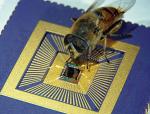The future is eye-tech
 Physiology Physiology
Can the humble fly help us to see better? Unlike the popular stereotype, fly eyes do not form thousands of little images - instead, they perceive one very fuzzy image of the world around it. Yet, with a brain the size of a grain of rice and only this fuzzy image to go on, how do flies see well enough to avoid getting swatted by us, or to perform a precise landing on a flower waving in the breeze? The answer, according to Dr David O'Carroll from the University of Adelaide's School of Molecular and Biomedical Science, is that flies have an exquisite sense of visual motion. It is this sense of motion that has a team of university scientists and engineers led by Dr O'Carroll, and known as the Visual Physiology Group, studying the brains and eyes of flies to develop artificial vision systems - computer chips that can see - that one day may provide the basis for a bionic eye. "As all animals move, the world moves past and so even stationary objects generate patterns of motion on our retina," he said. "Our eyes move continually to track this motion and the motion itself provides a powerful cue as to what we are doing in the world, as well as where features are and how large they are. "As we move past an object, its apparent speed depends on its distance, with close objects appearing to move faster, so the relative motion of objects provides a powerful sense of structure in the world." The Visual Physiology Group has already studied how flies perceive this visual motion, and copied the whole process onto a tiny computer chip. Dr Karin Nordstrom, a post-doctoral fellow in the Discipline of Physiology and a member of the Visual Physiology Group, said this is done by inserting an electrode in the fly's brain to enable researchers to record the activity in its brain cells. "We project images onto a computer screen that the insect views, and then we correlate that with the responses obtained from the insect's brain cells, which helps us understand how their brain analyses visual information. "The information obtained by the physiologists is then used by the engineers to build computer models of the insect brain and from there we can put it on the chips." These motion-sensing chips have a huge range of possible applications from more powerful anti-collision sensors in cars to optical gyroscopes for miniature aircraft. Dr O'Carroll said the development of this initial research for use in a human bionic eye, however, is still some years away. "Eye diseases with millions of sufferers worldwide, such as retinitis pigmentosa and macular degeneration, involve irreversible degeneration of the light sensitive layers of the retina in the eye, leaving sufferers with profound blindness," he said. "These diseases stop the retina from detecting the image focused onto it by the pupil, yet leave the nerve that connects the eye to the brain perfectly intact. So if a bionic eye could be developed to mimic the function of the retina, it could be coupled to the optic nerve in a similar way to the bionic ear. "The problem that others are having in trying to develop bionic eyes which fit this model is that the image our brain 'sees' comes from hundreds of thousands of very tightly packed relay nerve cells within the retina. These nerve cells couple each and every point of the image formed in the retina to the rest of our brains. "Trying to find a way to connect electrodes from an artificial device like a camera to each individual nerve cell correctly is very difficult, and even if we could, the packing of these cells is so dense that we couldn't achieve an image with a high enough resolution." Instead, Dr O'Carroll and his team are tackling the problem from a motion-sensing perspective, rather than an image-capturing one. "What we know is that specific visual areas in the temporal lobes of our brains contain motion processing centres remarkably similar to those of insects," he said. "Brain cells studied in that region respond to complex patterns of motion just like those found in the fly. "If electrodes were used to directly stimulate these brain regions, they could produce a sensation of the world moving without the need to map a bionic eye back onto the retina. "We think that this approach - building 'biomimetic' detectors for specific jobs and then mapping those to direct electrical stimulation of specific brain regions - offers advantages for the development of bionic devices. "Even a sense of motion would be very useful for an otherwise blind patient - allowing them to judge distance to nearby objects by the speed that they move." Story by Ben Osborne and Sukhmani Khorana Artificial vision research at the University of Adelaide has received another boost with the recent announcement of the Computational Neuroscience research cluster, one of five new clusters (see separate "A high five for research" story). Researchers from across the University will be involved in the multi-disciplinary cluster, representing such areas as Physiology, Philosophy, Genetics, Computer Science, Electronic Engineering, and Psychology. It will be led by Dr O'Carroll and Associate Professor Gerard O'Brien from the Discipline of Philosophy.
|





